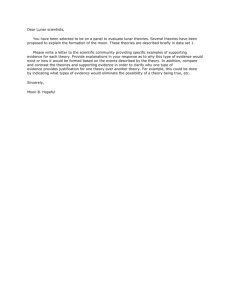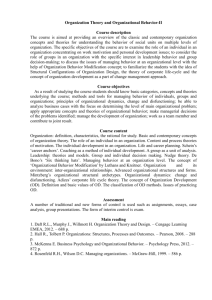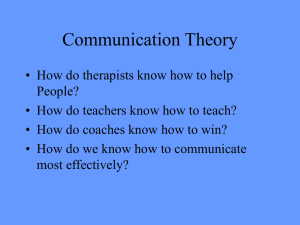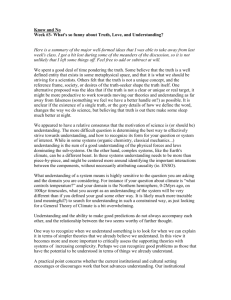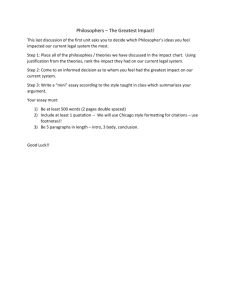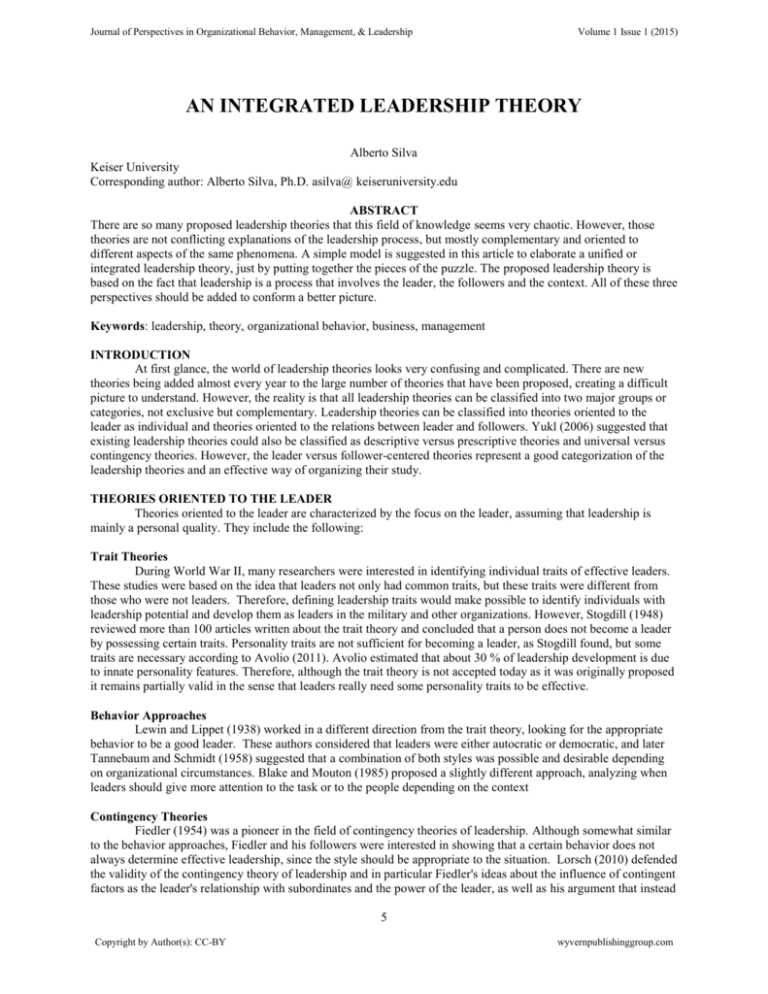
Journal of Perspectives in Organizational Behavior, Management, & Leadership
Volume 1 Issue 1 (2015)
AN INTEGRATED LEADERSHIP THEORY
Alberto Silva
Keiser University
Corresponding author: Alberto Silva, Ph.D. asilva@ keiseruniversity.edu
ABSTRACT
There are so many proposed leadership theories that this field of knowledge seems very chaotic. However, those
theories are not conflicting explanations of the leadership process, but mostly complementary and oriented to
different aspects of the same phenomena. A simple model is suggested in this article to elaborate a unified or
integrated leadership theory, just by putting together the pieces of the puzzle. The proposed leadership theory is
based on the fact that leadership is a process that involves the leader, the followers and the context. All of these three
perspectives should be added to conform a better picture.
Keywords: leadership, theory, organizational behavior, business, management
INTRODUCTION
At first glance, the world of leadership theories looks very confusing and complicated. There are new
theories being added almost every year to the large number of theories that have been proposed, creating a difficult
picture to understand. However, the reality is that all leadership theories can be classified into two major groups or
categories, not exclusive but complementary. Leadership theories can be classified into theories oriented to the
leader as individual and theories oriented to the relations between leader and followers. Yukl (2006) suggested that
existing leadership theories could also be classified as descriptive versus prescriptive theories and universal versus
contingency theories. However, the leader versus follower-centered theories represent a good categorization of the
leadership theories and an effective way of organizing their study.
THEORIES ORIENTED TO THE LEADER
Theories oriented to the leader are characterized by the focus on the leader, assuming that leadership is
mainly a personal quality. They include the following:
Trait Theories
During World War II, many researchers were interested in identifying individual traits of effective leaders.
These studies were based on the idea that leaders not only had common traits, but these traits were different from
those who were not leaders. Therefore, defining leadership traits would make possible to identify individuals with
leadership potential and develop them as leaders in the military and other organizations. However, Stogdill (1948)
reviewed more than 100 articles written about the trait theory and concluded that a person does not become a leader
by possessing certain traits. Personality traits are not sufficient for becoming a leader, as Stogdill found, but some
traits are necessary according to Avolio (2011). Avolio estimated that about 30 % of leadership development is due
to innate personality features. Therefore, although the trait theory is not accepted today as it was originally proposed
it remains partially valid in the sense that leaders really need some personality traits to be effective.
Behavior Approaches
Lewin and Lippet (1938) worked in a different direction from the trait theory, looking for the appropriate
behavior to be a good leader. These authors considered that leaders were either autocratic or democratic, and later
Tannebaum and Schmidt (1958) suggested that a combination of both styles was possible and desirable depending
on organizational circumstances. Blake and Mouton (1985) proposed a slightly different approach, analyzing when
leaders should give more attention to the task or to the people depending on the context
Contingency Theories
Fiedler (1954) was a pioneer in the field of contingency theories of leadership. Although somewhat similar
to the behavior approaches, Fiedler and his followers were interested in showing that a certain behavior does not
always determine effective leadership, since the style should be appropriate to the situation. Lorsch (2010) defended
the validity of the contingency theory of leadership and in particular Fiedler's ideas about the influence of contingent
factors as the leader's relationship with subordinates and the power of the leader, as well as his argument that instead
5
Copyright by Author(s): CC-BY
wyvernpublishinggroup.com
Journal of Perspectives in Organizational Behavior, Management, & Leadership
Volume 1 Issue 1 (2015)
of the leader changing his or her style according to the situation is easier to select the leader whose style has a better
fit to a given situation.
Leader’s Virtues
In the current stage of leadership research, it is commonly accepted that leaders should: a) be authentic,
acting as they are, without trying to imitate anyone (George, Sims, McLean, & Mayer, 2007); b) have an ethical
behavior, so that people can trust them (Mendenhall, et al., 2013); c) be responsible, making business decisions that
takes into account not only the interests of shareholders, but also other stakeholders such as employees, customers,
the environment, the community and future generations (Waldman & Balden, 2014); d) be able to handle crisis and
survive to them (George, 2009); and e) show adaptability, applying creativity to decision making in a difficult and
unexpected context in order to cope with complexity (Bennis & Thomas, 2002; Heifetz, Linsky & Grashow, 2009)
Women Leadership Theories
Ibarra, Ely and Kolb (2013) argued that there are many barriers for women to be leaders, but simply
identifying existing prejudices can help men and women understand what happens, and in particular free women to
focus more on leadership and less on how they are perceived. The effectiveness of women as leaders depends on
their own attitude and the acceptance of their leadership style in a given context.
THEORIES ORIENTED TO THE RELATIONSHIP BETWEEN LEADER AND FOLLOWERS
While recognizing the importance of theories oriented to the leader as an individual, theories oriented to the
relationship between leader and followers prevail today. Theories oriented to the relationship between leader and
followers include:
Transformational Leadership
Burns (1978) identified two general types or models of leadership: transactional leadership and
transformational or transforming leadership. By introducing the concept of transformational leadership, Burns
began one of the approaches to leadership that remains more relevant today. According to Daft (2008),
transformational leadership is characterized by the ability to cause significant changes in both the followers and the
organization. Several studies that have shown positive and consistent relationship between transformational
leadership behaviors and organizational performance (Avolio & Yammarino, 2013).
Power-Influence Approach
Machiavelli, a pioneer in power and political science studies, discussed the pragmatic behavior that should
have a ruler or political leader to succeed. Kotter (1979) and Pfeffer (1981) are two contemporary authors who have
revived the interest in leadership as an exercise of power in organizations. Kotter showed how leaders can develop
sufficient unofficial resources of power and influence to get the support that they need from subordinates, peers and
superiors. Pfeffer affirmed that potential leaders should stop looking at the world as a just and fair place and
actively develop the skills necessary to acquire and use power. Nye (2010) argued that power and leadership are
inseparable and leaders must learn the different conditions under which combine hard power resources, like rewards
and punishments, and soft power resources, like persuasion, for smart use of power.
Servant Leadership
The concept of servant leadership was introduced by Greenleaf (1991), in line with the leadership thought
of Lao Tzu, an ancient Chinese thinker, to describe a leader who listens, supports and seeks to build a community.
Leader-Member Exchange Theory
Liden et al. (1993) proposed the theory of exchange between leaders and followers. According to this
theory, leaders and followers must be able to develop effective relationships that result in progressive mutual
influence.
Shared Leadership
Pearce and Conger (2003) suggested that leadership must be seen as a process in which many persons of
the team are involved. Ibarra and Hansen (2011) affirmed that collaborative leadership is the appropriate leadership
style for a hyper-connected world, which makes unsuitable styles of command and control or consensus.
6
Copyright by Author(s): CC-BY
wyvernpublishinggroup.com
Journal of Perspectives in Organizational Behavior, Management, & Leadership
Volume 1 Issue 1 (2015)
Diversity and Multicultural Leadership
Mendenhall et al. (2013) suggested that a leader of global organizations should develop: a) multicultural
leadership competencies, such as cultural intelligence or the ability to function effectively in diverse cultural
contexts; b) cross-cultural communication skills; c) cross-cultural management of ethical issues; d) global mindset
or set of individual attributes that enable global leaders to influence those that are different from them; and e)
cosmopolitanism or level of natural interest and curiosity about different countries and cultures to that of oneself.
Team Leadership
Mendenhall et al. (2013) noted that studies show that teams in which people work face-to-face outperform
virtual teams. However, virtual teams are inevitable in today's organizations, geographically dispersed, and leaders
should ensure that members of these teams meet with a certain frequency, to talk and discuss with the aim of sharing
tacit knowledge and developing stronger relationships, and use a variety of technologies, depending on the different
aspects of the team task.
CONTEXT INFLUENCE
Avolio (2007), Javidan, et al. (2010), and Kellerman (2014) are some of the authors that insisted in the
influence of the context in the leadership process. These scholars affirm that leadership culture has been changing
dramatically with history, and that it is not the same to lead in China, United States, Brazil or England. Avolio
(2007) also affirmed that the relationship between the leader and the followers is a result of the organizational
climate in which it takes place.
INTEGRATED LEADERSHIP THEORY
Yukl (2006), Avolio (2007), and Mendenhall, et al. (2013), among other authors, expressed the need for
integration of the different leadership theories. An integrative approach seems quite feasible, at least in very simple
terms. As can be observed from the previous description, the leadership theories that have been proposed are not
different explanations of the same phenomena but different perspectives of it. None of these theories is in conflict
with another; on the contrary, the theories are mostly complementary. Therefore we can assume that instead of
many theories there is a single theory of leadership with different approaches within the general body of knowledge
of this field of study.
Avolio (2007) and Kellerman (2014) suggested that leadership is made of three components: leader,
followers and context. An equilateral triangle, as shown in Figure 1, has been proposed by Kellerman (2014) to
show the similar importance and the close relationship between these three components.
Figure 1. Leadership components
The different leadership theories that have been discussed above could be easily integrated, using the
triangle model proposed by Kellerman (2014), as shown in Figure 2.
7
Copyright by Author(s): CC-BY
wyvernpublishinggroup.com
Journal of Perspectives in Organizational Behavior, Management, & Leadership
Volume 1 Issue 1 (2015)
Figure 2. Integration of leadership theories
Building upon the scheme shown in Figure 2, an integrated leadership theory could then be developed. A
theory is a set of principles that provide an explanation of some aspect of the natural or social world, based in
observation, experimentation, and reasoning. The four basic principles of an integrated theory of leadership could be
expressed as follows: a) leadership is the process of achieving the desired goals of an organization or society
involving a leader and the collaboration between the leader and the followers within a given context; b) leaders are
primarily made, but they are also born with characteristics of intelligence, creativity and personality that are not
sufficient but necessary for them to become leaders; c) the main task of the leader is to cause a change in the
followers and in the society or organization that is involved; and d) the historical context, the culture, and the
organizational climate are external factors that impact to a great extent the leadership process.
CONCLUSION
The disparities between the different leadership theories or approaches that have been proposed in the last
eight decades are only superficial. In reality, those theories are oriented to different aspects of the same phenomena,
and integration is not only necessary but feasible. A simple model has been suggested in this article to elaborate a
unified or integrated leadership theory, just by putting together the pieces of the puzzle. The proposed leadership
theory is based on the fact that leadership is a process that involves a leader, the relation between the leader and his
or her followers, and the context. All of these three perspectives have been added to conform a better picture. The
resulting conceptual model could be used to help people know, understand, or simulate the complex subject of
leadership.
REFERENCES
Avolio, B. J. (2007). Promoting more integrated strategies for leadership theory-building. American Psychologist,
62(1), 25-33.
Avolio, B. J. (2011). Full-range leadership development. Thousand Oaks, CA: SAGE Publications, Inc.
Avolio, B. J., & Yammarino, F. J. (2013). Transformational and charismatic leadership: The road ahead. New York:
Emerald Group Publishing Limited.
Bennis, W., & Thomas, R. J. (2002, September). Crucibles of leadership. Harvard Business Review, 39-45.
Blake, R. R., & Mouton, J. S. (1985). The managerial grid III. Houston: Gulf Publishing Co.
Burns, J. M. (1978). Leadership. New York: Harper & Row.
Daft, R. L. (2008). The leadership experience (4th ed.). Mason, OH: South-Western Cengage Learning.
Fiedler, F. E. (1954, July). Assumed similarity measures as predictors of team effectiveness. The Journal of Abnormal
and Social Psychology, 49(3), 381-388.
8
Copyright by Author(s): CC-BY
wyvernpublishinggroup.com
Journal of Perspectives in Organizational Behavior, Management, & Leadership
Volume 1 Issue 1 (2015)
George, B., Sims, P., McLean, A. N., & Mayer, D. (2007, February). Discovering your authentic leadership. Harvard
Business Review, 85(2).
George, W. W. (2009). Seven lessons for leading in crisis. San Francisco, CA: Jossey-Bass.
Greenleaf, R. K. (1991). The servant as leader. Indianapolis, IN: Robert K. Greenleaf Center.
Heifetz, R., Linsky, M., & Grashow, A. (2009). The practice of adaptive leadership: Tools and tactics for changing
your organization and the world. Harvard Business Press.
Ibarra, H., & Hansen, M. T. (2011, July-August). Are you a collaborative leader? Harvard Business Review, 89(7/8),
68-74.
Javidan, M., Dorfman, P. W., Howell, J. P., & Hanges, P. J. (2010). Leadership and cultural context. In N. Nohria, &
R. Khurana (Eds.), Handbook of Leadership Theory and Practice (pp. 346-372). Boston, MA: Harvard
Review Press.
Kellerman, B. (2014). Hard times: Leadership in America. Stanford, CA: Stanford Business Books.
Kotler, J. P. (1979). Power in management. New York: Amacom Books.
Lewin, K., & Lippitt, R. (1938). An experimental approach to the study of autocracy and democracy: a preliminary
note. Sociometry, 1, 292-300.
Liden, R. C., Wayne, S. J., & Stilwell, D. (1993). A longitudinal study on the early developments of leader-member
exchanges. Journal of Applied Psychology, 78(4), 662-674.
Lorsch, J. (2010). A contingency theory of leadership. In N. Nohria, & R. Khurana (Eds.), Handbook of Leadership
Theory and Practice (pp. 411-429). Harvard Business Press.
Mendenhall, M. E., Osland, J., Bird, A., Oddou, G. R., Maznevski, M. L., Stevens, M., & Stahl, G. K. (2013). Global
leadership (2nd ed.). New York: Routledge.
Nye, J. S. (2010). Power and leadership. In N. Nohria, & R. Khurana (Eds.), Handbook of Leadership Theory and
Practice (pp. 305-332). Harvard Business Press.
Pearce, C. L., & Conger, J. A. (Eds.). (2003). Shared leadership: Reframing the hows and whys of leadership.
Thousand Oaks, CA: Sage.
Pfeffer, J. (1981). Power in organizations. New York: HarperCollins.
Stogdill, R. M. (1948). Personal factors associated with leadership: A survey of the literature. Journal of Psychology,
25, 35-71.
Tannenbaum, R., & Schmidt, W. H. (1958). How to choose a leadership pattern. Harvard Business Review, 36, 95101.
Waldman, D. A., & Balven, R. M. (2014). Responsible leadership: Theoretical issues and research directions.
Academy of Management Perspectives, 28(3), 224-234.
Yukl, G. A. (2005). Leadership in organizations (6th ed.). Upper Saddle River, NJ: Pearson Prentice Hall.
Dr. Alberto Silva is a full-time professor at Keiser University. He earned a Ph.D. in Business Administration from the
University of Almeria, Spain. His career includes managing responsibilities for more than thirty years in the private
and public sector and more than fifteen years as management professor at graduate level at several universities. Dr.
Silva is the author of a book on Management and of several articles on innovation and leadership.
9
Copyright by Author(s): CC-BY
wyvernpublishinggroup.com

